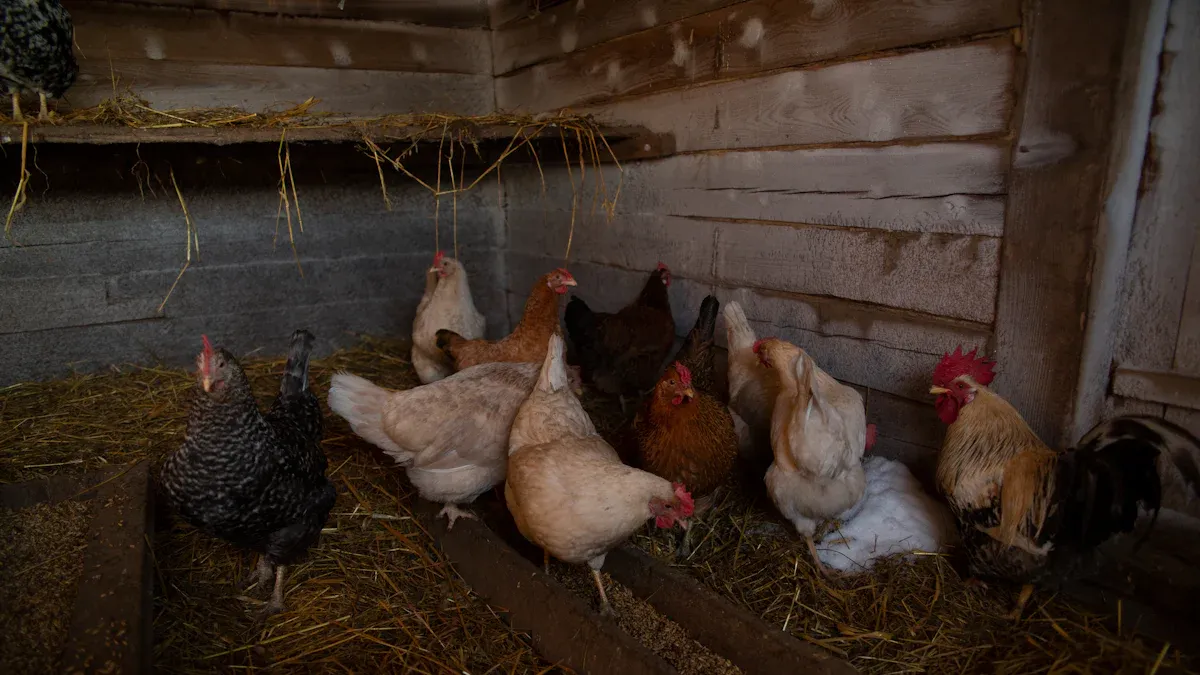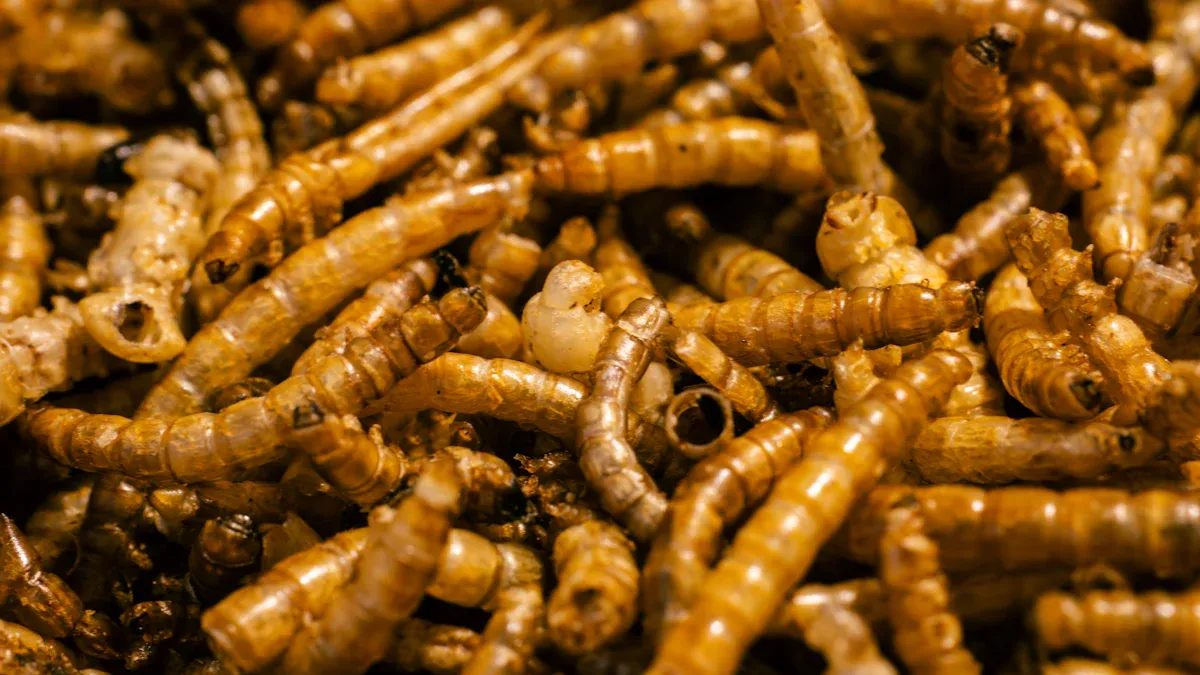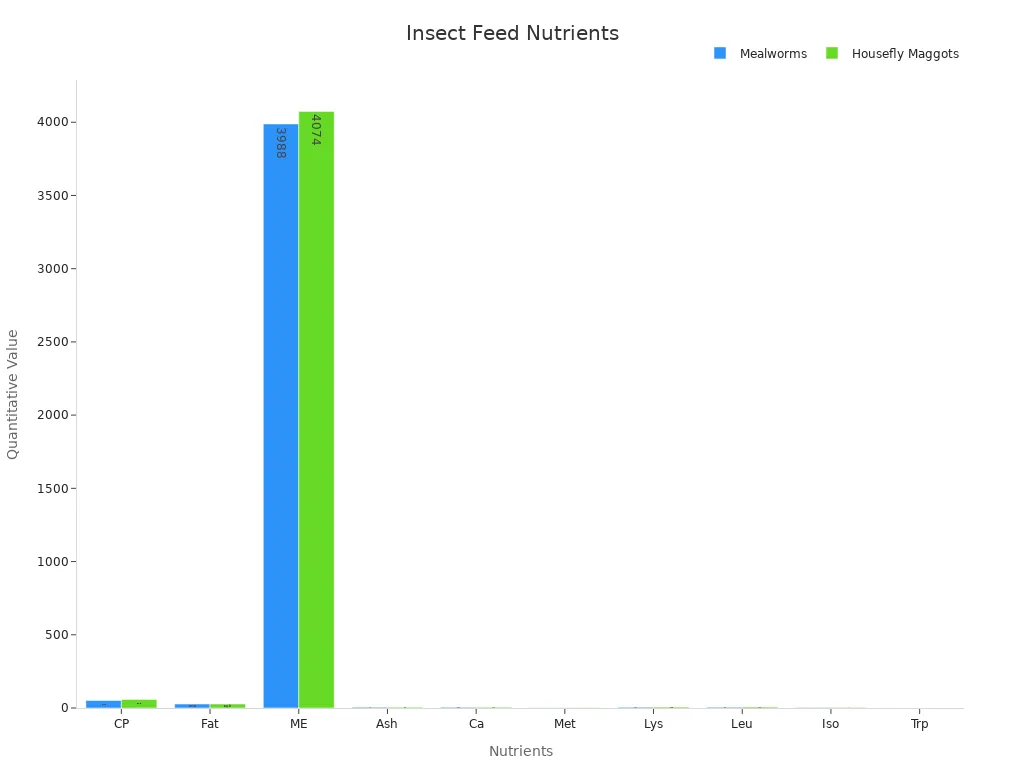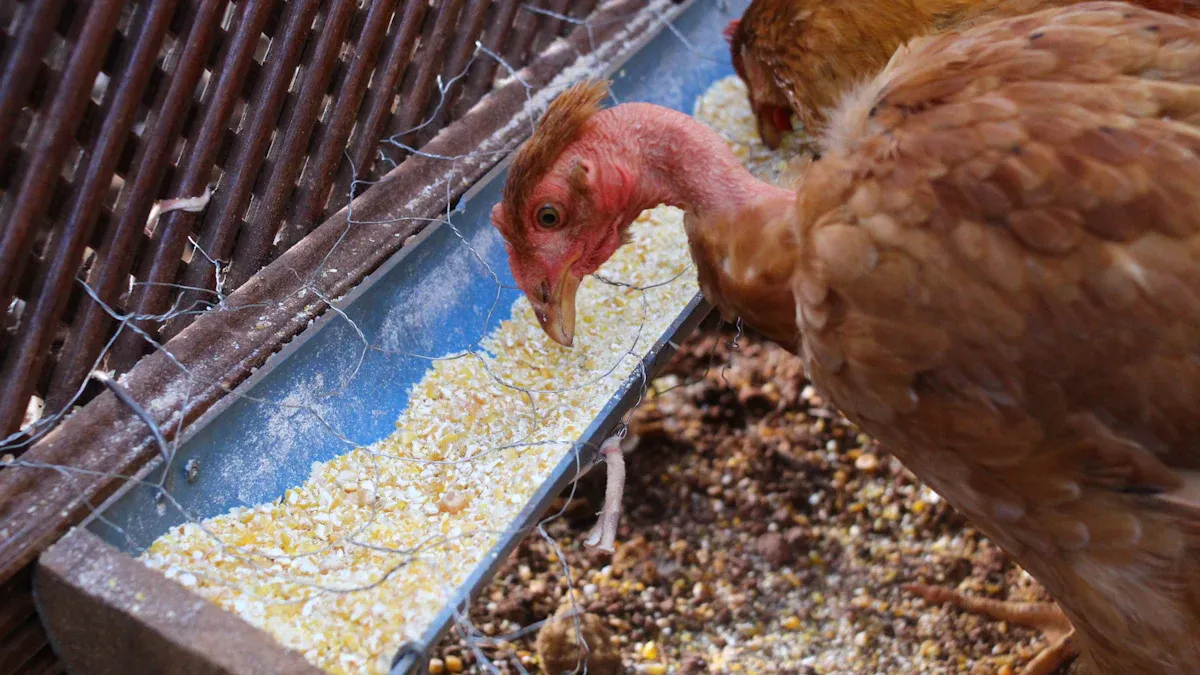
Many poultry keepers are curious about the benefits of mealworms in poultry nutrition compared to traditional feeds. The market for mealworms continues to expand, with North America and Europe at the forefront. Here’s an overview of the market landscape:
| Aspect | Details |
|---|---|
| Market Size (2023) | $1.98B |
| Growth Rate | ~5.48% CAGR, projected $3.2B by 2032 |
| Main Users | Poultry, aquaculture, pets, swine |
| Product Types | Live (largest), dried, meal, extract |
Incorporating mealworms in poultry nutrition offers a natural and nutritious option that promotes healthy birds and supports their growth and productivity.
Key Takeaways
- Mealworms provide high protein, essential amino acids, vitamins, and minerals that support healthy growth, egg quality, and immune health in poultry.
- Feeding mealworms at about 5% of daily feed improves weight gain, feed efficiency, egg production, and bird well-being without causing stress.
- Mealworms offer a sustainable, cost-effective alternative to traditional feeds by using less land and water and helping farmers reduce feed costs.
Mealworms in Poultry Nutrition: Nutritional Comparison

Protein and Amino Acids
Protein is a key part of any poultry diet. Chickens need it for muscle growth, feather health, and egg production. Mealworms in Poultry Nutrition stand out because they offer a protein content of about 51% by weight. This is close to what you find in fish meal and housefly maggots, and much higher than soybean meal.
| Nutrient / Parameter | Mealworms | Housefly Maggots | Fish Meal | Soybean Meal |
|---|---|---|---|---|
| Crude Protein (CP) | 51.02% | 57.8% | 58.5% | Significantly lower |
| Methionine (g/100g) | 2.3 | 2.27 | N/A | N/A |
| Lysine | 5.51 | 6.53 | Comparable | Lower |
| Leucine | 5.9 | 6.71 | Comparable | Lower |
| Isoleucine | 3.1 | 4.1 | Comparable | Lower |
| Tryptophan | 0.81 | 0.43 | N/A | N/A |
Mealworms also provide a strong amino acid profile. They contain essential amino acids like methionine, lysine, and leucine. These are important for healthy growth and egg quality. Studies show that chickens fed with mealworm meal can grow just as well, or even better, than those on traditional feeds.
Did you know? Mealworms meet the EU claim for “high protein” and can help poultry reach their daily protein needs.
Vitamins and Minerals
Vitamins and minerals keep chickens healthy and productive. Mealworms in Poultry Nutrition offer a rich supply of minerals such as calcium, phosphorus, magnesium, potassium, zinc, and manganese. These minerals support bone strength, eggshell quality, and immune function.
The table below shows how mealworms compare to other feed options:
| Nutrient / Parameter | Mealworms | Housefly Maggots | Fish Meal | Soybean Meal |
|---|---|---|---|---|
| Calcium (g/kg) | 5.23 | 5.13 | N/A | N/A |
| Phosphorus (g/kg) | N/A | 16.8 | N/A | N/A |
| Zinc (mg/kg) | N/A | 98.5 | N/A | N/A |
| Ash Content (%) | 5.7 | 5.9 | N/A | N/A |
Mealworms also contain high fiber (chitin), which can support gut health. Their mineral content matches or even exceeds that of many traditional feeds. This makes them a valuable addition to a balanced poultry diet.

Fatty Acids and Energy Content
Fatty acids and energy are vital for active, healthy birds. Mealworms in Poultry Nutrition have a high fat content, ranging from about 27% to nearly 48%, depending on what they eat. This fat provides energy for growth, egg laying, and daily activity.
Mealworms also offer a unique fatty acid profile. When raised on diets with seeds like flax or chia, their omega-3 levels go up. This improves the omega-6 to omega-3 ratio, making it healthier for chickens. For example, adding chia seeds to their diet can bring the ratio closer to 4:1, which is much better than the typical 50:1 found in some feeds.
The energy content of mealworms is also impressive. They provide about 3,988 kcal/kg, which matches or beats many standard poultry feeds. This means chickens get plenty of energy from a smaller amount of feed.
Tip: Because mealworms are so energy-rich, poultry keepers should feed them in moderation and balance them with other feeds.
Mealworms in Poultry Nutrition deliver high protein, essential amino acids, rich minerals, and healthy fats. They can help poultry thrive when used as part of a balanced diet.
Mealworms in Poultry Nutrition: Effects on Health and Productivity
Growth and Weight Gain
Mealworms in Poultry Nutrition can help chickens grow faster and healthier. Many studies show that adding mealworm meal to broiler diets increases body weight and daily weight gain. Chickens eat less feed but gain more weight, which means better feed efficiency. Here are some important findings:
- Mealworm meal up to 6% in broiler diets leads to higher body weight and daily gain.
- Feed conversion ratio improves, so chickens use their food better.
- Dressing percentage, which is the amount of usable meat, goes up with mealworm meal.
- Growth improvements come from the high-quality protein and balanced amino acids in mealworms.
- When mealworm meal replaces soybean meal at 5-15%, body weight and daily gain increase.
- Health markers like serum total protein, albumin, and globulin also improve with mealworm meal.
Researchers have also found that mealworm meal helps chickens during their early growth stages. For example, broilers fed 2.5% mealworm meal gained more weight in the first 10 days. Japanese quails fed mealworm scales showed higher breast percentage and better gut health. These results show that mealworms support strong growth and healthy development in poultry.
Egg Production and Quality
Mealworms in Poultry Nutrition can boost egg production and improve egg quality. Studies compare chickens fed mealworms with those on traditional feeds. The table below shows some key results:
| Parameter | Control Group | Mealworm Group |
|---|---|---|
| Body Weight Gain (g) | 1322.0 | 1423.3 |
| Feed Conversion Ratio | 1.88 | 1.75 |
| Gross Return (US$) | 0.34 | 0.41 |
Chickens eating mealworm-enriched feed produced over 5% more eggs than those on regular feed. Another study found that adding mealworm meal to laying hen diets did not always increase the number of eggs, but it did make the eggs better. The yolks became darker and richer in healthy fats, like linoleic acid and polyunsaturated fatty acids. These changes mean the eggs are more nutritious and appealing.
Mealworms also help chickens keep their feathers healthy, especially during molting. This can lead to better egg production and quality over time.
Immune Health and Disease Resistance
Mealworms in Poultry Nutrition do more than just help chickens grow. They also support the immune system and help birds fight off disease. Scientists have found that insect meals, including mealworms, act like prebiotics in the chicken gut. This means they help good bacteria grow, which keeps chickens healthier.
Several studies show that chickens fed mealworm meal have:
- Better gut health and stronger immune responses.
- Improved blood markers, like lower albumin:globulin ratios.
- Positive changes in gut microbiota and mucin, which protect the intestines.
For example, broilers fed 2.5% and 5% mealworm meal had better body weight and lower albumin:globulin ratios. Other research found that mealworm diets improved gut structure, like villus height and crypt depth, which helps chickens absorb nutrients better. These benefits make chickens more resistant to disease and stress.
Behavior and Well-being
Mealworms in Poultry Nutrition can make chickens happier and more active. Chickens love mealworms and will work hard to get them, even when they are not hungry. This shows that mealworms are rewarding and make chickens feel good.
| Behavioral Indicator | Description and Observation | Interpretation and Link to Well-being |
|---|---|---|
| Preference for mealworms | Hens prefer mealworms over other foods and will work to obtain them even when full. | Mealworms are rewarding, reflecting positive welfare. |
| Increased approach speed to mealworm container | Hens approach the container faster over repeated days. | Shows anticipation and excitement, linked to positive feelings. |
| Increased pecking frequency | Hens peck more at the mealworm container. | Indicates motivation and enjoyment. |
| Increased activity and focus | Hens show more activity and attention towards mealworms. | Suggests positive emotional states and better well-being. |
Studies also show that feeding mealworms does not cause extra stress. Chickens fed mealworms have similar stress hormone levels and physical health scores as those on regular feed. They also show more natural behaviors, like foraging and wing flapping, which are signs of good welfare.
Tip: Adding mealworms to the diet can be a fun way to enrich your flock’s environment and keep them active.
Mealworms in Poultry Nutrition: Feeding Guidelines
How to Incorporate Mealworms
Poultry keepers can add mealworms to their birds’ diets in several ways. Some choose to scatter dried mealworms on the ground, encouraging natural foraging. Others mix mealworm meal into regular feed. Both methods work well and help chickens stay active. Scientific studies show that the size of mealworm feed matters for growth. Mealworms grow best when their food is ground into small pieces, less than 2 mm. This helps farmers produce healthy mealworms for poultry diets.
Tip: Try offering mealworms as a treat during training or enrichment activities. Chickens love the taste and will come running!
Recommended Amounts and Frequency
Researchers have tested different amounts of mealworms in poultry diets. The table below shows what works best for broiler chickens and turkeys:
| Poultry Species | Larvae Type | Inclusion Level (% of daily feed) | Frequency | Observed Effects |
|---|---|---|---|---|
| Broiler Chickens | Yellow Mealworm | 5% | Once daily | Better growth and feed efficiency |
| Broiler Chickens | Black Soldier Fly | 5%–10% | 1–2 times | More activity; 10% may lower final weight |
| Turkeys | Black Soldier Fly | 10% | Once daily | Improved weight gain and feed conversion |
Most experts suggest keeping mealworms at 5% of the daily feed for best results.
Balancing Mealworms with Other Feeds
Mealworms in Poultry Nutrition work best as part of a balanced diet. Studies show that adding 2.5% to 5% mealworm meal improves growth and gut health without causing problems. Mealworms provide protein, fat, vitamins, and minerals, but chickens still need grains and other feeds for complete nutrition. Farmers who use food by-products to feed mealworms also help the environment. This makes mealworms a smart and sustainable choice for poultry diets.
Mealworms in Poultry Nutrition: Cost-Effectiveness and Sustainability

Price Comparison with Traditional Feeds
Many poultry farmers want to know if mealworms save money compared to regular feeds. Studies show that using insect-based meals, like mealworms or black soldier fly larvae, can lower total feed costs. One study found that replacing fish meal with insect meal improved the cost-benefit ratio, reaching as high as 2.12 at a 20% inclusion rate. This means farmers spent less and still saw good growth in their chickens. The price of mealworm feed depends on several things, such as the size of the farm, the cost of the food used to raise mealworms, and local market prices. Large farms often pay less per pound because they buy in bulk and use efficient systems.
Sourcing and Availability
Mealworms in Poultry Nutrition have become easier to find in recent years. The market for mealworm feed is growing fast, with a value of about $1.2 billion in 2023. Experts expect it to reach $3.4 billion by 2032. Farmers can buy mealworms in different forms, such as dried, live, or processed, which makes them flexible for many types of poultry operations. Big companies now produce mealworms at scale, so supply is more stable. In Asia Pacific, government support and a growing livestock industry help make mealworms even more available.
- Mealworms need less land and water than traditional feeds.
- They offer high digestibility and support better growth and egg production.
- Farmers can choose the product form that fits their needs.
Environmental Impact
Mealworm production is better for the environment than many traditional feeds. Life Cycle Assessment studies show that mealworms use less land and create less global warming potential per kilogram of protein than beef, pork, or chicken. While mealworm farms use some energy for heating, their overall carbon footprint stays low. Improvements in automation and feed can make mealworm farming even greener. Low land use is important because it helps protect natural resources for future food production.
Note: Choosing mealworms helps poultry farmers support a more sustainable and eco-friendly agriculture system.
Mealworms in Poultry Nutrition: Risks and Limitations
Potential Health Concerns
When adding mealworms to poultry diets, farmers should watch for a few health concerns. Mealworms can sometimes carry bacteria like Clostridium, Staphylococcus, and Bacillus cereus. These bacteria may cause illness if not managed well. Viruses such as norovirus and hepatitis A or E might also be present in the feed substrate, but these viruses do not multiply inside insects. Some parasites, including Giardia and Toxoplasma, can stick to insects, though studies show only a low risk of parasite problems in mealworms.
Chemical safety is another point to consider. Fungi like Aspergillus and Fusarium can produce mycotoxins, which are harmful chemicals. So far, research has not found clear signs of mycotoxin buildup in mealworms. Farmers should also know that high levels of mealworm meal—like 15% of the diet—can change the gut structure in chickens. Birds may have shorter villi and deeper crypts in their intestines, which could lower feed efficiency. Most studies show no major problems at lower inclusion rates.
Tip: Always use mealworms from trusted sources and follow feeding guidelines to keep flocks healthy.
Regulatory and Safety Considerations
Rules for using mealworms in poultry feed differ by country. Most places require approval before farmers can use insects as feed. Here’s a quick look at how some countries handle this:
| Country | Regulatory Authority | Key Requirements |
|---|---|---|
| European Union | European Commission | Approval for yellow mealworms; strict rules due to past disease outbreaks; novel feed approval needed. |
| Canada | Canadian Food Inspection Agency (CFIA) | Approval for new feed ingredients; some insect species already allowed for poultry. |
| Republic of Korea | Ministry of Agriculture, Food, and Rural Affairs | Approval needed for new feed ingredients. |
| China | Ministry of Agriculture and Rural Affairs | Approval required for novel feeds. |
| Japan | Ministry of Agriculture, Forestry and Fisheries | Approval needed for new feed ingredients. |
| Australia | APVMA | Standards must be met; new materials may not need approval if they fit guidelines. |
| Nigeria | NAFDAC | No current regulations for insect feed. |
Farmers should check local rules before adding mealworms to poultry diets. Following these rules helps keep food safe for both birds and people.
Mealworms offer high protein, essential nutrients, and sustainable sourcing. The table below highlights key points:
| Pros | Cons |
|---|---|
| High calcium and protein, GMO-free, sustainable | Some chickens need time to adjust, price |
Poultry keepers can start with moderate amounts. Dehydrated mealworms provide easy storage and nutrition. Ongoing research will help improve cost and acceptance.
FAQ
Are mealworms safe for all types of poultry?
Yes, mealworms work well for chickens, ducks, and quail. Farmers should always follow feeding guidelines for best results.
How should poultry keepers store dried mealworms?
Keep dried mealworms in a cool, dry place. Use an airtight container to keep them fresh and prevent moisture.
Can mealworms replace all traditional feeds?
No, mealworms should supplement regular feed. Birds need a balanced diet with grains, greens, and other nutrients for full health.


